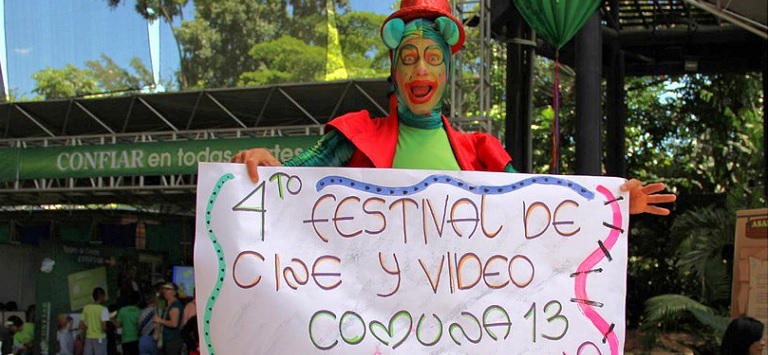A troubled neighborhood in Colombia’s second biggest city of Medellin is set to hold their 4th annual film festival, aiming to tell stories that give more nuance – and hope- than the usual tales of violence and poverty told about the district in the news.
“La Otra Historia” Film and Video Festival will run from on September 29 to October 4 in Communa 13, in Medellin’s western hillsides, which less than 15 years ago was the scene of battles between guerrilla, paramilitaries and the army.
“The festival was born from the need to expose all these social, community, and artistic projects that have been taking place in Comuna 13 in Medellin. From there comes the name “The Other Story,” we hope to tell another history that the main stream media doesn’t tell,” said Luis Fernando Avendaño, Director of the Comuna 13 Film Festival in an interview with Colombia Reports.
Crowd-sourcing international guests
The Festival is being financed by the Mayor’s Office, the Ministry of Culture and some private donors, but the Festival is currently undergoing a crowd-funding campaign to be able to bring international guests.
You can support the Festival here.
Luis Fernando hopes to bring as many international guests as possible because “one of the objectives of the festival is a socio-cultural exchange with peripheries at the nationally and internationally.”
Comuna 13 is a traditionally poor and one of the most violence riddled neighborhood in Medellin. Gang violence has resulted in mass displacement as well as a high death rate of the community’s youth.
MORE: Children dismembered, parents threatened: a week in Medellin’s Comuna 13
“Cinema shows us what is happening in different regions in the country, and how the communities themselves perceive their problems,” explained Luis Fernando, adding that, “It is important that these independent productions circulate and stimulate a social dialogue. It as an opportunity for the festival organizers to show the work that is being done to move the community forward.”
International guest-list
Invited Guests include:
- Marcio Blanco, the Director of Festival Visiones Perifericas from Brasil that uses cinema and animation to work with youth in Brazil’s favelas.
- Toni Navarro, Director of International Festival on Human Rights in Barcelona.
- Jose Luis Sepulveda, from the International Social and Anti-social Film Festival in Chile.
- Libia Stella Gomez, recognized Colombian filmmaker y screenwriter from Bogota. Leading the Festival’s screenwriting workshop from August 1 to August 6, with a talk at the Publica Piloto Library at 4PM on August 1.
- Patricia Martin, film expert from Argentina who will be hosting a workshop on film marketing and networking.
The exchange of ideas will include proposals like “micro-cinemas” from a Bolivian organization. Luis Fernando would like to see more micro-cinemas which is an alternative way to see movies and give exposure to the productions of independent filmmaker’s. The idea is to find rooms and auditoriums for at least 30 people and show Latin American films there. A symbolic fee of roughly $1 would be charged to cover operation costs.
Colombian cinema as a form of social inclusion
“In the past the problem was production, but now it is exhibition and distribution. These are independent films which propose certain topics and discussions but they are not being circulated, such as very good films like ‘Silencio en el Paraiso‘ and ‘Choco‘. This festival will be opened with the film Petecuy which was financed by the United Nations and chronicles urban violence in Cali,” exclaimed Luis Fernando in a n interview with Colombia Reports.
Petecuy is a neighborhood in the south eastern city of Cali. The neighborhood took in a large population of displaced people from the Pacific coast and the surrounding region, most of them young men. It is riddled with unemployment, crime, and gang violence dubbing it the name “Pete-plomo” (Pete-gunfire).
This clip below shows an interview with the Director of the film and then the trailer of the movie itself. Director Oscar Hincapie says that “Petecuy had one of the highest rates of violence and homicide in the country, but regardless we went in to produce the film to attempt to show that art can become a powerful tool of social inclusion and development,” adding that “Colombia is becoming a filmmaker’s paradise.”
Colombian cinema often uses local actors from the area they are filming in, offering a unique insight into the lives of Colombians.
Sources
- Interview with Director of “La Otra Historia” Film Festival, Luis Fernando Avendaño
- 4° FESTIVAL DE CINE Y VIDEO COMUNA 13 ¨LA OTRA HISTORIA¨
- FESTIVAL DE CINE COMUNA 13 (Crowdfunding)
- Medellin’s Turbulent Comuna 13 (Insight Crime)


